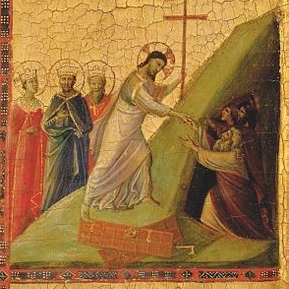
Here is Jesus pulling people out of hell. This was the dominant picture of hell for many years. ‘Look! Jesus rescues people from hell.’ A hopeful picture.
This picture is one of six which together make up the Scenes from the Life of Christ, by Giovanni di Rimini, usually seen in Rimini, but currently, until 8 October, in a special small exhibition at the National Gallery in London. The catalogue describes the painting as showing the standard highlights of the life of Jesus. At the time, 1300 – 1305, it was normal to show Jesus pulling people out of hell.
Jesus pulling people out of hell is usually called The Harrowing of Hell. Harrowing here has an old, Middle English, meaning of Despoiling. Jesus is making hell impotent, depleted, empty. This is an accepted and important part of what Jesus came to do.
Very soon, though, this picture changed dramatically. Dante’s Inferno, the most influential book on hell ever, was written about 1314. Over the door of Dante’s hell is written ‘Abandon hope all you who enter here.’ The idea that Jesus can and does pull people out of hell was quashed. Fear replaced hope.
Dante was writing graphically about the hell described by the theologian Thomas Aquinas. The Church made this ‘no hope, more fear’ version of hell the dominant one. The Harrowing of Hell was no longer painted. Instead we see
 Photo from www.visitwiltshire.co.uk
Photo from www.visitwiltshire.co.uk
Here Jesus presides over people being thrown into a vividly tormenting hell. Jesus is far removed from these people, and seems not to care about them. Their awful fate is sealed as decided, or supervised, by Jesus.
These pictures, of the Doom, or Last Judgement, became common, replacing the Harrowing of Hell. Above is the best preserved English painting, in St Thomas’ Church, Salisbury, painted about 1475.
 Photo by Paolo Villa – Own work, CC BY-SA 4.0, https://commons.wikimedia.org/w/index.php?curid=39353393
Photo by Paolo Villa – Own work, CC BY-SA 4.0, https://commons.wikimedia.org/w/index.php?curid=39353393
Here is perhaps the most well-known Last Judgement painting, from the Duomo Cathedral in Florence. The artist Vasari began this in 1568 and it was completed by Federico Zuccari in 1579.
As in the English painting, the people in inescapable torment in hell are closest to the congregation. Seeing these agonised people, remote from Jesus, gives a very different message from seeing Jesus pulling people out of hell. ‘Look Jesus presides over people being tormented in hell forever.’
Hell changed in the early 1300s. The painting now in the National Gallery is perhaps the last still to show Jesus pulling people out of hell.
Why did the picture of hell change then? What is the true picture of hell? My book The Lie of Hell www.laddermedia.co.uk gives answers. Or search ‘hell’ for other posts on this blog.
The picture of hell has changed. It needs to change again – to the Hades and Gehenna about which Jesus spoke. Hades the tormenting remand prison before Final Judgement; Gehenna the unquenchable fire after Final Judgement where some unrepentant humans are destroyed, body and soul. This dual picture includes Jesus having, and, by implication, using, the keys of Hades, pulling people out of Hades. A stern warning and a serious, sure, splendid, hope.
Roger Harper
Tags: Church, Giovanni di Rimini, Hell, National Gallery
August 26, 2017 at 6:11 am |
Yesterday we visited Burton Dasset country park just off the M40 j12. The church is C 14. There is a damaged picture of the harrowing of Hell with a bloody hand visible. Diane asked about the phrase. Your article answered her and showers why it is important. The the pictures you talk about show how we lost the meaning, and also lost the population who cannot believe God is so mean as to prevent them having any Hope of eternal life. Sent from my Windows 10 phone
August 26, 2017 at 8:53 pm |
Thanks Philip. Interesting. I’ll go and see the picture when I can. I guess that it’s early C14 – also one of the late Harrowing pictures.
June 27, 2022 at 2:46 pm |
[…] The publication of Dante’s book, Inferno, in about 1314 was the final, decisive, agent of this change. Since at least the teaching of Augustine of Hippo in the early 5th Century, the understanding of hell as eternal torment by the eternal devil had lived uneasily beside the understanding of hell as open to the rescuing influence of Jesus who has defeated the devil. The image of souls who have worshipped the beast being tormented with fire and sulphur, the smoke of their torment going up forever and ever (Revelation 14:10,11) was taught alongside Jesus’ proclamation that he has the keys of death and Hades (Revelation 1:18.) In Art, Jesus pulling people out of hell was the dominant picture. After Dante, people being tortured in hell by the devil became the dominant picture. For more on this change see https://rogerharper.wordpress.com/2017/08/23/changing-the-picture-of-hell-23-august/ […]
April 27, 2023 at 9:21 am |
[…] Dante’s Inferno has had a malign influence on Western Christendom. This book finally enshrined hell as the place where people, souls, burn in torment for ever, under the authority of the devil. Once inside, no escape is possible, for eternity. Jesus looks on from a great distance, unconcerned. Before Inferno, the popular depiction of hell was of a sharp-toothed grave from which Jesus rescues people, souls. This ‘Harrowing of Hell’ was shown in church pictures and in passion plays. After Inferno, the picture changed. See Changing the picture of hell: 23 August | Rogerharper’s Blog (wordpress.com) […]